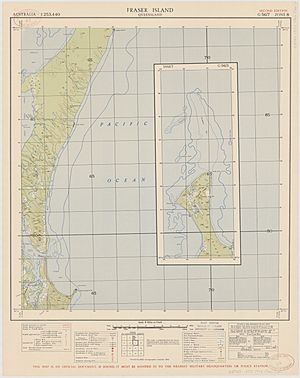Sandy Cape facts for kids
Sandy Cape is the most northern point of Fraser Island in Queensland, Australia. It's a special place known for its beautiful beaches and wildlife. Famous explorer James Cook named this cape in 1770. He was sailing on his ship, the Endeavour, exploring the eastern coast of Australia.
South of Sandy Cape are two other ocean points: Waddy Point and Indian Head. James Cook also named Indian Head during his voyage.

Contents
Nature and Wildlife
Sandy Cape is part of the Great Sandy National Park. This means it's a protected area. A long sand formation called BreakSea Spit stretches about 30 kilometers north from the cape.
This remote, sandy area is a very important home for sea turtles. Many loggerhead and green turtles come here to lay their eggs. This special nesting place is called a rookery. To protect the baby turtles, driving on the beach at night is not allowed during nesting season.
The plants at Sandy Cape are quite tough. They are short and shaped by the strong winds. The sand dunes closest to the ocean have a light covering of spinifex grass. This grass helps to hold the sand in place.
Visiting Sandy Cape
You can only reach Sandy Cape by driving along the eastern beach. This is best done at low tide. Camping is allowed in the area. It is also a popular spot for people who enjoy fishing.
A Look Back in Time
Many ships have sailed past Sandy Cape over the years. Some even ran into trouble near its shores.
Early Explorers
In 1802, explorer Matthew Flinders landed at Sandy Cape. He was on his ship, the Investigator. He wrote about the empty landscape he saw. In August 1803, two ships, the Cato and the Porpoise, sank near the cape during bad weather.
Later, in December 1842, the HMS Fly anchored near Sandy Cape. Some of its crew and naturalists went ashore. They also noted how sparse and empty the area was. The Fly returned in April 1845. This time, they found a good supply of fresh water behind the beach.
Shipwrecks and the Lighthouse
More ships were wrecked near Sandy Cape. The Seabelle sank in 1857, and the Chang Chow in 1884. These waters might have hidden sandbars that caused problems for ships.
Because so many ships were sinking, the Sandy Cape Light was built in 1870. This lighthouse helped guide ships safely past the cape. It also marked the first time Europeans settled permanently on Fraser Island. Another ship, the SS Marloo, was wrecked here in September 1914.
Weather Station
In 1891, a man named Clement Lindley Wragge set up many weather stations across Queensland. One of these was at Sandy Cape. Today, the cape is still used to help with weather observations.


